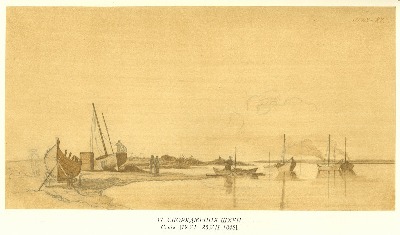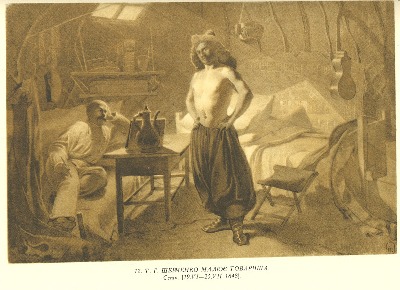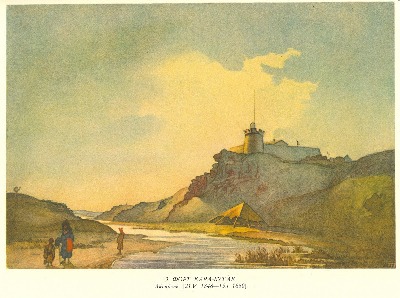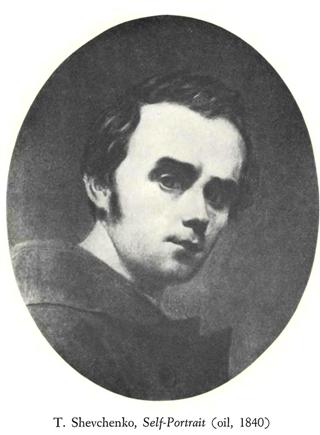TARAS SHEVCHENKO’S LIFE AND WORK
Taras Shevchenko as a member of Aral Sea Expedition (1848 - 1849)
(Introduction of "The poetical works of Taras Shevchenko. The Kobzar" by Constantine Henry Andrusyshen and Watson Kirkconnell)
In the spring of 1848, the government organized an expedition under Captain O. Butakov to study the as yet unexplored Aral Sea, its depths and coastline, writh a view to the advisability of building fortifications upon its shores for further imperialist expansion in the direction of Afghanistan. The expedition needed an experienced draughtsman to sketch the salient places where fortresses might be constructed. And so, at Butakov's instance and after investigating Shevchenko's behaviour, the military authorities at Orenburg decided to appoint him to that task, although no permission had as yet arrived from St. Petersburg to free him from the curtailment of drawing and painting. On May 9 Shevchenko received instructions from Orenburg that he was being relieved from the regiment at Orsk and attached to the expeditionary battalion, with the right to draw and sketch anything that was considered necessary. Although, according to those who had lived in the Aral region, life at Orsk was an Eden in comparison, Shevchenko felt a sense of relief. The next day he was on the way to his new destination.

Taras Shevchenko, "Schooners preparation"
The caravan was made up of 2,500 waggons and 3,500 camels. The sections of the schooner Konstantin were being transported on conveyances. The manpower consisted of some 200 infantry, 600 Bashkir horsemen, and a detachment of cavalry, all under the command of General Schreiber. In that conglomeration, Shevchenko was treated not as a common soldier, but as a member of the expedition, and as such enjoyed special privileges from the commanders; among other alleviations, he was not required to wear a uniform. The first day of the journey proved unbearable, and Shevchenko who could not endure the insufferable heat, and was in addition highly excited by the sudden change, experienced a fainting spell. The terrain through which they moved was a monotonous wilderness, a boundless plain wild with the steppe-grass but with no other growth or sign of life. On the way Shevchenko sketched a few landscape scenes, several Russian military forts, and burial mounds. Then followed seven days of tormenting journey across the horrible desert of Karakum with its extremes of temperature — cold, windy elevations and hot valleys full of black sand on which, as Shevchenko noted both in his Diary (Shchodennik) and in the novel The Twins (Bliznetsi) an egg could be fried in five minutes. The thirst suffered by man and beast was intense, and when finally they reached the desert wells the water in them was so bitter, salty, acid, and full of minute creatures that it was tolerable to drink only after it had been sieved and boiled. Shevchenko was fortunate in having a few lemons with which to flavour his tea and so subdue his thirst. However, the worst was yet to come. Their further journey lay across a pale roseate plain which was the bottom of a dried up lake and, in the intense sunlight, was so dazzling that one could proceed only with eyes closed. Shevchenko, hke his companions, was temporarily blinded by it. Finally, the shores of the Aral Sea were reached, and the air became fresher. But there still remained some fifty miles to the Rayim Fort, their destination іn the Syr-Daria River. This part of the journey was possible only by night, for the temperature during the day was almost a steady 115° F. On June 19, after thirty-nine days of forging ahead, they arrived at that Fort which stood solitary amid the utterly gloomy Kirghiz steppe-land.
In that god-forsaken spot, while he waited thirty days for the schooner Konstantin to be assembled, Shevchenko sketched and painted the mournful scenes around him, oppressed by unrelenting heat and troubled sorely by scorpions and tarantulas. Then, on July 25, when all was in readiness, the Konstantin, in the company of its mate the Nikolai, sailed from the Rayim Fort down the Syr-Daria River towards the Aral Sea. Shevchenko was aboard the former together with the commander Butakov and twenty-five others, all in very restricted quarters. It took them about a week to reach the Sea, at the entrance to which the schooners separated, each to investigate different parts of it. Up till September 26 the explorations continued under the most horrible conditions: lack of fresh food, scorching heat, storms, and often hurricanes, the more dangerous because the soundings of the depths had not yet been established and the vessel often ran into shallows and struck against hidden rocks. The topographical measurements and the exploration of the unmapped islands were completed in thirty-eight days, following which the expedition headed towards the island of Kos-Aral where they cast anchor and prepared to pass the winter after two months of almost continuous seafaring.

Taras Shevchenko, "Shevchenko draws a friend"
The winter with its storms began early, on October 22, and in that snow-bound locality Shevchenko spent some four months during which he continued to draw and paint, but mostly to write, in order to obliterate as best he could the monotony and boredom. Vermin, however, with which all the members of the expedition were infested, became an insoluble problem. Mail reached that forlorn spot only twice a year, but Shevchenko failed to receive any communication whatever from the outside world. All seemed to have forgotten him, and this troubled him painfully. Scrofula attacked him, and his physical deterioration continued. It was not relieved even when, at the end of January 1849, he returned for a two-month's stay to the Rayim Fort where two physicians attended him. His appearance also changed. He had now a fully bearded face, his hair began to thin out visibly, and his former sturdy physique became lean. He was aging fast. At times, under the influence of rum, his melancholy would leave him, but a relapse would always follow and he would again grow reticent with his friends or vocal in cursing his evil fate. At least twice he took part in tiger hunts, and on one of them sketched a dead tiger. Occasionally, when the snow-storms subsided, he and others would visit the local Kirghiz beys. But all those diversions could not in the end alleviate his deep-rooted grief and mental torment.
Willingly would he have exchanged this state for the former at Orsk, but Butakov insisted that he remain with him till the end of the expedition. And so, on May 5, Shevchenko again found himself on board the Konstantin as it started on its second voyage of exploration which this time was to last four months. The investigation was begun from the western precipitous shores which made it virtually impossible for the crew to disembark. The squalls continued to plague them, and once the hurricane was so strong that the vessel had to be made fast by three anchors. Although Butakov made certain that this time the provisions were fresher and less perishable, the sea water which they drank during a storm that lasted two weeks made the men so sick at their stomachs that they were incapacitated for any kind of work and brought Shevchenko to such a pass that he cared little whether he lived or died. Once when they went ashore, he felt so desperate that he deliberately separated himself from his companions and would not answer their call when the time for reembarking came; when he was found, it was with difficulty that he was persuaded to return on board.

Taras Shevchenko. "Fort Kara Butak."
The expedition completed its work by September 22. In two excursions, lasting about seven months, the Aral's surface was measured, its depths sounded, and its coast line mapped and studied. Shevchenko's contribution was over two hundred sketches and drawings which enhanced the immense research in both practical and artistic respects. However, it could not be publicly acknowledged, because it was only at Butakov's instance and on the Orenburg military officialdom's sufferance that he did that kind of work; the formal confirmation of his release from the interdict was still lacking. Personally, he profited from the research by often working with the naturalist Werner, thus acquiring considerable knowledge of botany and geology.
The party returned to Kos-Aral and from there to the Rayim Fort, back to vermin, scorpions, and blowing, blinding sands. Shevchenko Was pain-stricken that in the mail awaiting them there he received not single letter. Did his friends forget him altogether? How could they be so ungrateful to him for what he had done to further their national cause at the price of his freedom? Of course, he had no way of knowlng that all his mail had been stopped at Orenburg. Even so, the correspondence he later received was from precious few of his friends (including Princess Repnin); many others in Ukraine who had promised to write him failed to communicate.
On October 10, for the second time, Shevchenko had to cross the dreaded desert on his way to Orenburg, part of the 1,000 kilometers on foot in order to lessen the horses’ fatigue as they trudged uphill. Thus, after two and a half years of most bitter experiences since he left the town for Orsk, he reached Orenburg on November 1.
Since his imprisonment at Orsk, his “bootleg” collection had increased by some seventy items, large and small, most of them written on Kos-Aral. A greater part of them was lyrical, subjective, and autobiographical poems into which he poured his distress as he described the wretchedness of his life. Their Dantesque refrain could be reduced to the outcry: “Nessun maggior dolore/Che ricordarsi del tempo felice / Ne la miseria,” which Shevchenko paraphrased in one of his lyrics. Besides several longer narrative poems, he wrote ballads and a considerable number of songs with folklorist content. As always, many of his poems of that period derive from his lasting interest in the Cossack age and reveal the manners and customs of those bold and happy-go-lucky warriors in both their exuberant and their subdued moods. The general tenor of his creativeness, however, is grief for his lost youth and sorrow at being forgotten by his countrymen.
Introduction written by Professor C.H. Andrusyshen
Source: The Poetical Works of Taras Shevchenko. The Kobzar. Translated from the Ukrainian by С.H. Andrusyshen and Watson Kirkconnell. Published for the Ukrainian Canadian Committee by University of Toronto Press, 1964. Toronto and Buffalo. Printed in Canada, Reprinted, 1977, p. 28 - 32.
Read more:

Introduction of "The poetical works of Taras Shevchenko. The Kobzar" by Constantine Henry Andrusyshen and Watson Kirkconnell.



